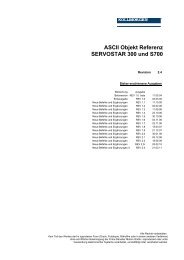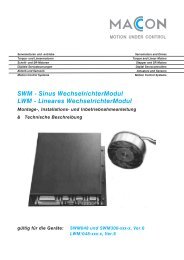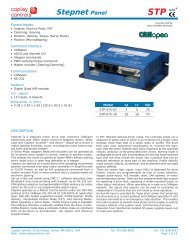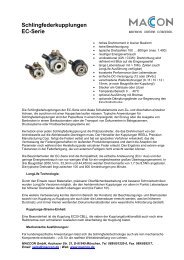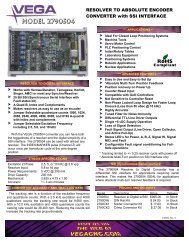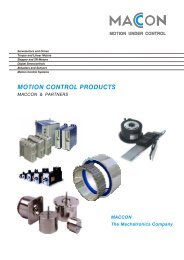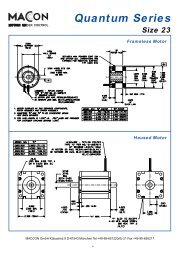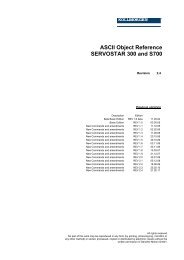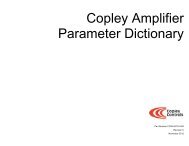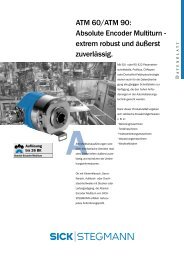CANopen Programmer's Manual - Maccon.de
CANopen Programmer's Manual - Maccon.de
CANopen Programmer's Manual - Maccon.de
You also want an ePaper? Increase the reach of your titles
YUMPU automatically turns print PDFs into web optimized ePapers that Google loves.
6: Homing Mo<strong>de</strong> Operation <strong>CANopen</strong> Programmer’s <strong>Manual</strong><br />
HARD STOP MODE HOME DELAY INDEX 0X2351<br />
Type Access Units Range Map PDO Memory<br />
Unsigned 16 RW milliseconds 0 - 10,000 YES RF<br />
Description<br />
Delay used for homing to a hard stop mo<strong>de</strong>.<br />
HARD STOP MODE HOME CURRENT INDEX 0X2350<br />
Type Access Units Range Map PDO Memory<br />
Integer 16 RW 0.01A 0 - 32,767 YES RF<br />
Description<br />
Home current in hard stop mo<strong>de</strong>, in which the amplifier drives the motor to the mechanical end of<br />
travel (hard stop). End of travel is recognized when the amplifier outputs the Hard Stop Mo<strong>de</strong><br />
Home Current for the Hard Stop Mo<strong>de</strong> Home Delay time (in<strong>de</strong>x 0x2351, p. 186).<br />
HOME CONFIG INDEX 0X2352<br />
Type Access Units Range Map PDO Memory<br />
Unsigned 16 RW - See Description, below. YES RF<br />
Description<br />
Alternate method for configuring the homing mo<strong>de</strong>. Provi<strong>de</strong>s more flexibility than the standard<br />
<strong>CANopen</strong> method does. Bit-mapped as follows:<br />
Bits Description<br />
0-3 Home function.<br />
Value Description<br />
0 If bit 5 is not set, then just set the current position as home. If bit 5 is set, then move in the<br />
direction specified by bit 4 and set the location of the first in<strong>de</strong>x pulse as home. Bit 6 is not used<br />
in this mo<strong>de</strong>.<br />
1 Move in the direction specified by bit 4 until a limit switch is encountered. Then move in the<br />
other direction out of limit. If bit 5 is clear, then the edge location is home. If bit 5 is set, then the<br />
next in<strong>de</strong>x pulse is home. Bit 6 is not used in this mo<strong>de</strong>.<br />
2 Home on a constant home switch. The initial move is ma<strong>de</strong> in the direction specified by bit 4.<br />
When the home switch is encountered, the direction is reversed. The edge of the home switch<br />
is set as home if bit 5 is clear. If bit 5 is set, then an in<strong>de</strong>x pulse is used as the home position.<br />
Bit 6 is used to <strong>de</strong>fine which in<strong>de</strong>x pulse is used.<br />
3 Home on an intermittent home switch. This mo<strong>de</strong> works the same as mo<strong>de</strong> 2 except that if a<br />
limit switch is encountered when initially searching for home, then the direction is reversed. In<br />
mo<strong>de</strong> 2, hitting a limit switch before finding home would be consi<strong>de</strong>red an error. Bit 8 i<strong>de</strong>ntifies<br />
which edge of the home to search for (positive or negative).<br />
4 Home to a hard stop. This moves in the direction specified in bit 4 until the home current limit is<br />
reached. It then presses against the hard stop using that current value until the home <strong>de</strong>lay time<br />
expires. If bit 5 (in<strong>de</strong>x) is set, drive away from the hard stop until an in<strong>de</strong>x is found.<br />
4 Initial move direction (0=positive, 1=negative).<br />
5 Home on in<strong>de</strong>x pulse if set.<br />
6 Selects which in<strong>de</strong>x pulse to use. If set, use the pulse on the DIR si<strong>de</strong> of the sensor edge. DIR is the<br />
direction specified by bit 4 of this word.<br />
7 If set, capture falling edge of in<strong>de</strong>x. Capture rising edge if clear.<br />
8 When using a momentary home switch, this bit i<strong>de</strong>ntifies which edge of the home switch to reference on. If<br />
set, then the negative edge is used; if clear the positive edge is used.<br />
9 If set, make a move to the zero position when homing is finished. If clear, the zero position is found, but not<br />
moved to.<br />
10 If set, the homing sequence will run as normal, but the actual position will not be adjusted at the end. Note<br />
that even though the actual position is not adjusted, the Homing Adjustment (in<strong>de</strong>x 0x2353, p. 188) is<br />
updated with the size of the adjustment (in counts) that would have been ma<strong>de</strong>.<br />
Also, if bit 10 is set then no move to zero is ma<strong>de</strong> regardless of the setting of bit 9.<br />
186 Copley Controls




